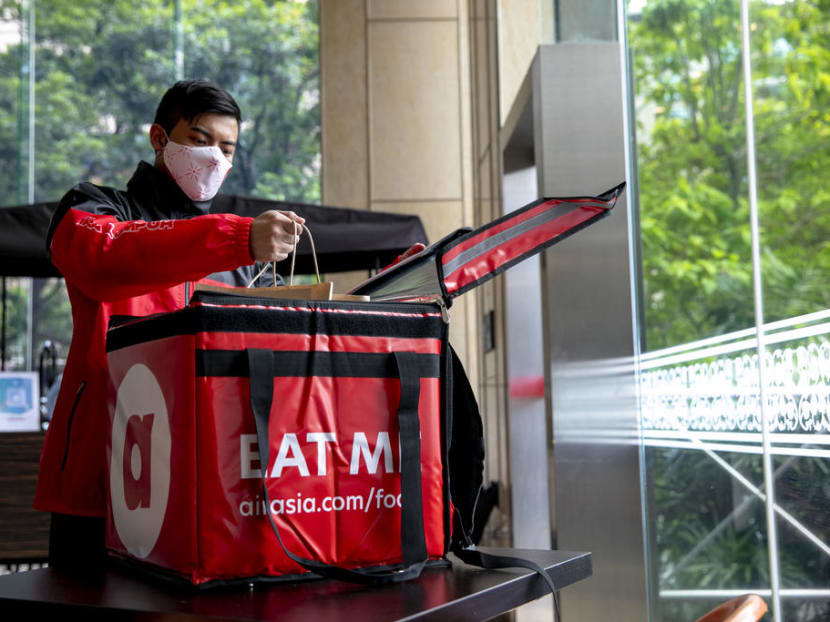AirAsia Food review: New food delivery firm shows potential as cheaper option despite early glitches, 8pm service end time
SINGAPORE — It was a little past 8pm on a recent Friday, my usual downtime for some mindless scrolling on social media, when I was reminded that AirAsia had just launched its food delivery service in Singapore and was offering free deliveries for orders within 8km.

The AirAsia Food service may take some getting used to, and faces some early glitches, but it might yet provide a viable cheaper alternative food delivery option for Singaporeans.
- A spinoff from the no-frills airline, AirAsia Food is a no-frills app that takes some getting used to
- The service operates only till 8pm, so don’t depend on it to satisfy your late-dinner cravings
- It also doesn't give estimated food delivery times upfront. Twice, it took 35 minutes before alerting the arrival time
- There were at least two technical glitches, with one quoting S$100 delivery fees
- But it has at least gotten the basics right, delivering food at rates and timings that can rival what the established players offer
SINGAPORE — It was a little past 8pm on a recent Friday, my usual downtime for some mindless scrolling on social media, when I was reminded that AirAsia had just launched its food delivery service in Singapore and was offering free deliveries for orders within 8km.
I asked my husband if he wanted some post-dinner bubble tea, popped open the app, and readied myself to name him the merchants that could be ditching the three food delivery giants here – GrabFood, FoodPanda and Deliveroo – for AirAsia Food.
The new entrant had announced to some fanfare last month that it would undercut its market rivals by charging merchants a commission rate of 15 per cent.
TODAY understands that commissions charged by the three major food delivery platforms range between 25 and 35 per cent, although this may vary depending on the size of the outlet involved.
However, my search for defectors that night was most anti-climactic: I found none.
And for every other listed stall that I clicked through, including hyped supper spot Swee Choon Tim Sum, a message would pop up saying that the restaurant was closed and it would take only pre-orders.
Surely, there must be some mistake, I thought. Was the app being buggy?
With every disappointing encounter that night, my appetite for bubble tea dwindled along with my expectations for the app to save food-and-beverage (F&B) operators from having their profits squeezed by commission-hungry food delivery leaders.
I closed the app and forgot about it, until I was tasked to review it for TODAY a few days later.
Four orders on the app later, I realised that I might have been a little too quick to dismiss AirAsia Food for its poor curation of merchants and “restaurant is closed” fails.
At its core, the app does deliver food at rates and timings that rival what the established players are offering, although its users will have to take some time to figure out its logic and work their way around its limitations as a no-frills app.
OPERATES ON A DIFFERENT LOGIC
AirAsia Group’s chief executive officer Tony Fernandes had forewarned users of this.
“Just like AirAsia doesn’t have all the frills of Singapore Airlines, AirAsia Food, for instance, (won’t) have maps. We don’t think you really need to know where your driver is, because that costs us,” he said at the Singapore launch of AirAsia Food on March 2.
As it turns out, besides not having the real-time parcel-tracking feature, its service operates only from 11am to 8pm daily, which explains why every shop was closed when I was evaluating my options at 8.30pm that day.
When I verified this with Mr Lim Ben-Jie, the head of e-commerce for the AirAsia app, he said that there are plans to extend the operating hours in the future, but it would, for the time being, follow the operating hours of its delivery partner, AirAsia’s logistics arm Teleport.
There are also no upfront estimated delivery arrival times.
The first two times I ordered from AirAsia Food, I was informed via a WhatsApp message only 35 minutes after making payment that my food would arrive in 20 to 30 minutes. Both times, the food took one hour in all to arrive.
My third order, from a restaurant 2km away, took 30 minutes, and I got a message 16 minutes in to say that my order would take 20 to 30 minutes more to arrive, which was not accurate because the food arrived sooner.
The fourth time, I didn’t get any alerts at all until my order, from a restaurant 12km away, arrived 42 minutes later.
Although this was well within the 47-minute estimated delivery time listed on Grab for the same restaurant, I wish I hadn’t had to put up with the anxiety of manually refreshing my order details page in case something had gone wrong with the order.
On the delivery times to be expected of the app, AirAsia’s Mr Lim told TODAY that the average time from order creation to delivery would be 35 to 40 minutes for deliveries within 10km. Delays could be a result of “external factors” such as weather, traffic, or the merchant’s timeliness in preparing the food, he added.
If I were to nitpick, I also wished that I didn’t have to key in my credit card details anew each time I made an order. Mr Lim said that the app would start saving credit card details only from mid-April.
A RUSHED JOB?
While these might have been planned trade-offs to keep overhead costs low and make delivery affordable for users and merchants, there were at least two major technical glitches that gave the sense that the app just wasn’t tested well enough for a seamless market rollout. They made its Singapore launch feel rushed.
One related to a software bug that resulted in users being wrongfully quoted S$100 in delivery fees.
Another one, which I experienced on Monday, was that users were wrongfully perceived to be more than 100km away, and prevented from completing their order.
I was already at the payments page after selecting some food from Swee Choon, located about 10km away from my home in Marine Parade, when I was met with an error message that said: “The payment method is disabled due to distance being more than 100km.”
The same issue arose when I tried ordering from other restaurants, as long as they were located outside of an 8km radius from my address.
Mr Lim said that the two issues have been resolved.
When asked, he declined to reveal the number of orders that AirAsia Food had fulfilled so far, but said that about 100 merchants had listed on its platform as of Friday.
CHEAPEST FOR NOW, BUT WILL IT STAY THIS WAY?
Is AirAsia Food value-for-money feature enough for consumers to overlook all of its teething problems? It is for now, for its “unlimited” free delivery promotion for orders within 8km runs until next Tuesday, making it the cheapest food delivery option out there.
For instance, I paid just S$13 for a pasta dish to be delivered from a restaurant 2km away to my doorstep, when the same item would cost S$14.99 to deliver via FoodPanda and S$18.30 to deliver via GrabFood.
But it remains to be seen whether it will remain the cheapest option once the free delivery deal is over in a few days, although there is hope, given that the company had promised delivery fees 5 per cent lower than its competitors.
To give a gauge, AirAsia Food’s delivery fee for a patisserie located 12km away was S$11.99, lower than the S$13.40 delivery fee over at GrabFood.
Even if cost remains comparable, I found it appropriate to be told again of its mission to put in place a fairer commission system for the F&B scene, which would show no favour to bigger players with multiple restaurants under its watch.
Mr Lim reminded me of this when I asked why certain food retailers such as Maki-San are taking only pre-orders on AirAsia Food when they do on-demand deliveries on other food delivery platforms, and whether it is because they are charged even lower commissions.
Pointing out that some of the merchants had opted for pre-orders for now as they would like their employees to get used to its ordering system first, he said: “All commission rates are standard across the board, with no exclusivity for any merchant.”
He added that for now, AirAsia Food is still charging merchants using a flat fee model, where they subscribe to a prepaid business plan.
The 15 per cent commission model will take effect only in the middle of April, he noted.
AirAsia Food could yet fill the gap for what the bigger apps can’t do for the smaller F&B industry players.








